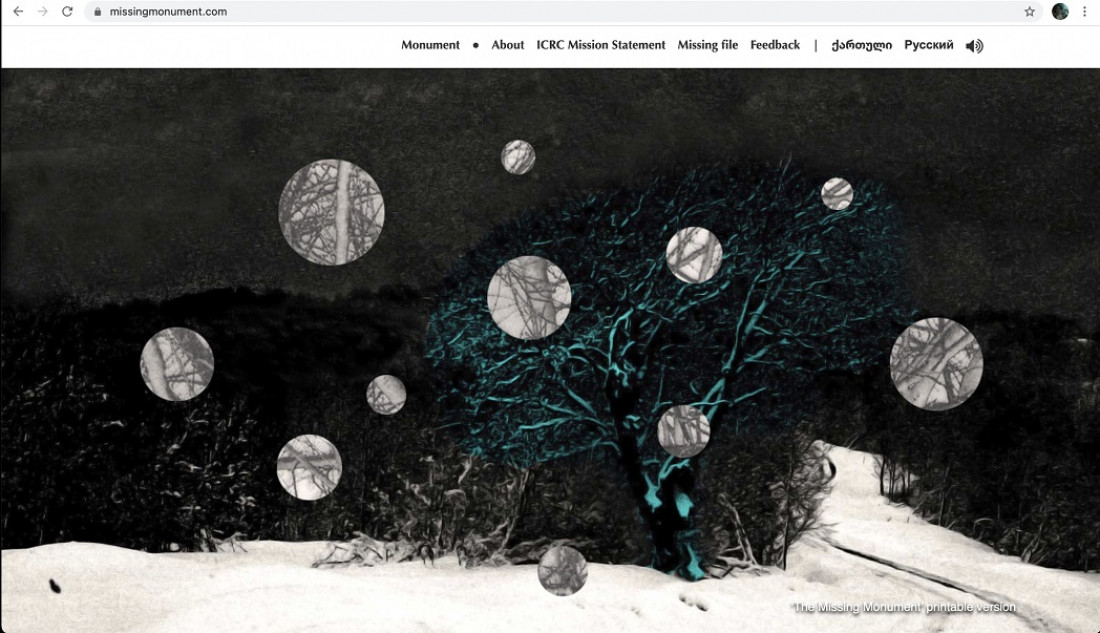Missing Monument
Tamar Chabashvili
digital
2019
www.missingmonument.com
The Missing Monument is an online project initiated and supported by the International Committee of the Red Cross (ICRC) and can be viewed here: www.missingmonument.com
In 2019, while working on the exhibition “The Corridors of Conflict: Abkhazia 1989-1995,” I got in touch with the issue of missing persons for the first time. My attention was drawn to a bundle of handwritten papers that listed and recorded the names of missing, imprisoned, or killed persons from both sides of the conflict. I was astonished by the number of disappeared persons as one folder could contain the records of thousands. I began to read the handwritten notes tracing the last encounters, stories, and whereabouts of the missing ones.
One of the key subjects in my work is the theme of trace. For me, each new project is an attempt to unravel the inheritance of the past, and search for the traces and paths in order to speak about the emotional impact they had on me. I belong to the generation of artists who were in their teens during the 1990s, hence, the process of discovering and challenging our personal boundaries coincided with bigger and more important events in our reality: the break-up of the Soviet Union; the installment of new borders... As a result, the emergence of ethnic conflicts completely overshadowed our personal biographies. The experience of working with a group of people whose lives were directly affected by those events, helped me broaden up the context in which the retracing of embodied memory can be positioned. It inspired me to question by whom and with what means are the interpretations of the past created and in what manner are “counter-memories” and “counter-stories” meant to fill up the space of silence.
On a formal level, I was inspired by the form of a tree: as a symbol of life and a metaphor for continuity, stability, and strength. More particularly, my idea was to create a wish tree on which everyone, independently of their nationality, age, ethnicity, or religion could attach their message or a wish. I created twelve different trees one could visit, with the “sound tree” acting as an opening of the exhibition. Like a chorus in Greek tragedy, the sound tree provides the atmosphere and brings together different voices, creating a shared space for the missing persons. The other eleven trees can be visited one by one in a trajectory chosen by a visitor. Each tree brings a story representing one aspect of disappearance, hence, the stories are fragmented, like remembrance itself. The narrative is created from different fragments taken from poems, interviews, and testimonies.
Throughout the process, I was searching for ways to capture the mental presence and the physical absence of the missing persons, as well as the manner of mapping individual memories preserved by their families as acts of remembering. Finally, I wanted to retrace memory imprints into material forms and preserve them as an archive of incomplete stories and endless loss.
‘Storytelling can take many forms and there are as many forms as there are ways of waiting.’* Thus, during each visit, the reading of the story will be different, comparable to each individual experience of missing. The aim of this project is not to provide an answer or a set of solutions, but to invite us to think about these experiences in terms of living, shifting, diverse, and embodied acts of commemoration – in other words, as acts against forgetting.
* Andreas Bandak and Manpreet Janeja (eds.), (2018), Ethnographies of Waiting: Doubt, Hope and Uncertainty, (London: Bloomsbury).

